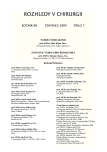Infrarenal Aortic Graft Infection
Authors:
J. Herman; P. Utíkal; Z. Sekanina; P. Bachleda
Authors‘ workplace:
II. chirurgická klinika FN a LF UP Olomouc, přednosta: doc. MUDr. P. Bachleda, CSc.
Published in:
Rozhl. Chir., 2009, roč. 88, č. 7, s. 349-352.
Category:
Monothematic special - Original
Overview
Introduction:
The incidence of vascular replacement infection is reported between 0.5–6.0%. The infection of aortal valve replacement is usually managed by its removal and axilofemoral reconstruction. Replacement removal and reconstruction in situ is another alternative. The aim of our work is to give the comparison of the results obtained with the extra-anatomic reconstruction and alternative techniques.
Materials and methods:
Between January 1987 and August 2008 1324 abdominal aortal replacements were performed in our department. In 14 patients (1.05%) the infection of the replacement occurred; one of the patients was operated on in another hospital. In eight patients axilobifemoral/axilopoplietal by-pass was applied (Group A). In two patients the whole replacement was removed together with in situ reconstruction (ISR) using a new bifurcation replacement. In two patients a partial resection of the replacement and the resected part substitution or femoro-femoral cross-over by-pass was performed. Three patients were treated with a total or partial replacement removal without the following reconstruction.
Results:
In Group A no haemorrhage from the aortal stub occurred. The mean value of surgical management due to the replacement infection was 3.5 (1–6). For Group B the number was 5 (1–16). In Group B there were three reinfections, in Group A none. In both Group A and B one patient died; one thigh amputation was necessary in Group A, two in Group B.
Conclusions:
The partial or total removal of the replacement followed with in situ reconstruction is considered a safe and good method solving the infection of the aortal replacement in some patients. The results are comparable to those obtained with extra-anatomic reconstruction that remains the method of choice in patients with virulent infections.
Key words:
graft infection – axilobifemoral bypass – in situ reconstruction
Sources
1. Brown, P. M., Kim, V. B., Lalikos, J. F., et al. Autologous superficial femoral vein for aortic reconstruction in infected fields. Ann. Vasc. Surg., 13: 32–36, 1999.
2. Swain, T. W., Calligaro, K. D., Dougherty, M. D. Management of Infected Aortic Prosthetic Grafts. Vasc. Endovascular. Surg., 2004 Jan-Feb; 38(l): 75–82.
3. Bandyk, D. F., Novotney, M. L., Back, M. R., et al. Expanded application of in situ replacement for prosthetic grafit infection. J. Vasc. Surg., 2001, 34: 411–420.
4. Seeger, J. M. Management of patients with prosthetic vascular graft infection. Am. Surg., 2000 Feb; 66(2): 166–177.
5. Oderich, G. S., Bower, T. C., Cherry, K. J. Jr., et al. Evolution from axillofemoral to in šitu prosthetic reconstruction for the treatment of aortic graft infections at a single center. J. Vasc. Surg., 2006 Jun; 43(6): 1166–1174.
6. Cardozo, M. A., Frankini, A. D., Bonamigo, T. P. Use of superficial femoral vein in the treatment of infected aortoiliofemoral prosthetic grafts. Cardiovasc. Surg., 2002 Aug; 10(4): 304–310.
7. Clagett, G. P., Valentine, R. J., Hagino, R. T. Autogenous aortoiliac/femoral reconstruction from superficial femoral-popliteal všine: feasibility and durability. J. Vasc. Surg., 1997, 25: 255–270.
8. Staffa, R., Kříž, Z., Vlachovský, R. Hluboká žíla dolní končetiny jako tepenná náhrada při řešení infekce cévní protézy. Rozhl. Chir., 2008, 87, 4: 186–189.
9. Young, R. M., Cherry, K. J., Davis, P. M., et al. The Results of In Situ Prosthetic Replacement for Infected Aortic Grafts. Am. J. Surg., 1999, 178: 136–140
Labels
Surgery Orthopaedics Trauma surgeryArticle was published in
Perspectives in Surgery

2009 Issue 7
Most read in this issue
- Septic Shock in a Patient with the Fourniér Gangrene with Fatal Outcome
- Complications of IPOM Plasty – Our Experience
- The Complication of a Periproctal Abscess – Fourniér’s Gangrene or Necrotizing Fasciitis? A Case Report
- Anti- biotic Prophylaxis in Urology
